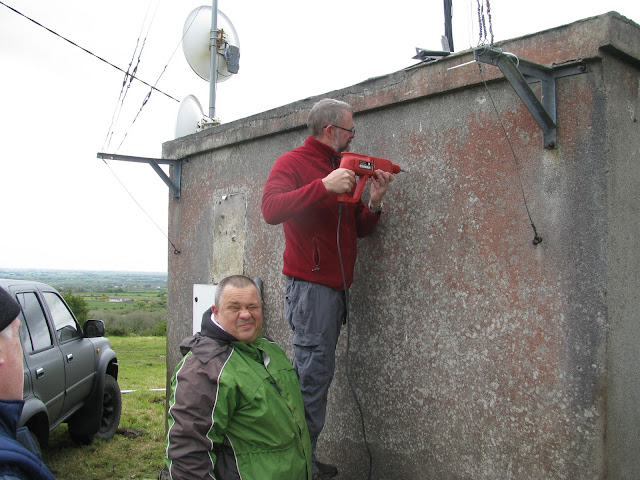A meeting prior to the installation ensured that all parts had been purchased and also who currently had them in their possession. The last item required was the 20ft pole. John looked after the purchase and delivery of the pole to the site.
Gerry took charge of the guying equipment and all of the necessary parts were handed to him. Andrew took charge of the fencing materials and the parts for the fourth guy which needed to be set in the ground on the day.
Steve held the repeater, sundry items and spares should they be required.
The group met in Abbeyknockmoy and headed for the site. Marlow joined us and oversaw the operation on his site.
The first task was to work on the brackets to hold the pole against the wall of the hut. Gerry took charge of this with the assistance of Arek.
The next task was to organise the staying point for the fourth guy. Joe and Andrew looked after this duty. A fair bit of digging was involved until a huge lump of rock was found.
This rock was going nowhere so the best course of action was to drill into the rock and insert a rawl bolt. This has a couple of small clamps added and the fourth guy was affixed to this. Concrete and rocks were poured over this and then the rest of the earth covered it. A small fence was built around this area to prevent cattle damaging the guy and staying point.
The pole was raised to ascertain the length of the steel guys and also the fourth guy which would have been longer. Once this was done it was time to bolt the antennas to the pole.
The raising of the mast was not too difficult with a little muscle and weight behind the mast
Gerry spent much of the time on the roof of the hut ensuring that the guys were secure. The tensioners did not need adjustment so there will be plenty of play to tighten them in the event of the guys stretching.
And so the last of the guys were attached and secured to the Rawl Bolt on the rock. With all in place it was time to look upward and see the results of the work done.
And then into the hut where John had been working on the installation of the Repeater and the APRS Digipeater.
A great day was enjoyed by all. The installation took four hours to complete. A great days work was done by all with special thanks to the Team - John EI1EM. Tom EI2GP, Joe EI3IX, Steve EI5DD, Andrew EI3FEB, Gerry EI8DRB, and Arek EI9GWB and not forgetting Martin List-Petersen who oversaw the operation and took the photographs shown here.
Gerry took charge of the guying equipment and all of the necessary parts were handed to him. Andrew took charge of the fencing materials and the parts for the fourth guy which needed to be set in the ground on the day.
Steve held the repeater, sundry items and spares should they be required.
The group met in Abbeyknockmoy and headed for the site. Marlow joined us and oversaw the operation on his site.
The first task was to work on the brackets to hold the pole against the wall of the hut. Gerry took charge of this with the assistance of Arek.
The next task was to organise the staying point for the fourth guy. Joe and Andrew looked after this duty. A fair bit of digging was involved until a huge lump of rock was found.
This rock was going nowhere so the best course of action was to drill into the rock and insert a rawl bolt. This has a couple of small clamps added and the fourth guy was affixed to this. Concrete and rocks were poured over this and then the rest of the earth covered it. A small fence was built around this area to prevent cattle damaging the guy and staying point.
The pole was raised to ascertain the length of the steel guys and also the fourth guy which would have been longer. Once this was done it was time to bolt the antennas to the pole.
The raising of the mast was not too difficult with a little muscle and weight behind the mast
Gerry spent much of the time on the roof of the hut ensuring that the guys were secure. The tensioners did not need adjustment so there will be plenty of play to tighten them in the event of the guys stretching.
And so the last of the guys were attached and secured to the Rawl Bolt on the rock. With all in place it was time to look upward and see the results of the work done.
And then into the hut where John had been working on the installation of the Repeater and the APRS Digipeater.
A great day was enjoyed by all. The installation took four hours to complete. A great days work was done by all with special thanks to the Team - John EI1EM. Tom EI2GP, Joe EI3IX, Steve EI5DD, Andrew EI3FEB, Gerry EI8DRB, and Arek EI9GWB and not forgetting Martin List-Petersen who oversaw the operation and took the photographs shown here.

























